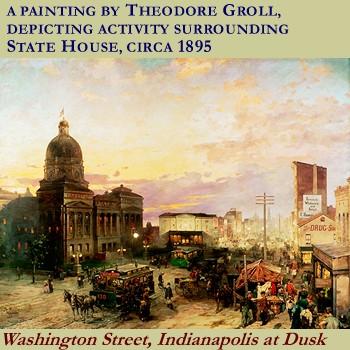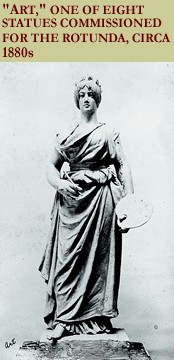 Competition to design the new Statehouse attracted drawings from more than twenty architects. The General Assembly was looking for an impressive public building that would far outlast the first capitol building, both in style and in structural stability. Having learned from the problems of the Capitol, the General Assembly specified that the new building was to stand on a solid foundation.
Competition to design the new Statehouse attracted drawings from more than twenty architects. The General Assembly was looking for an impressive public building that would far outlast the first capitol building, both in style and in structural stability. Having learned from the problems of the Capitol, the General Assembly specified that the new building was to stand on a solid foundation.
In 1878 the Board of Statehouse Commissioners selected the submission of Edwin May, an Indianapolis architect, for the state's new capitol building. May estimated that his building would cost $1,792,911.60; the legislature mandated that construction costs not exceed $2 million.
May titled his design Lucidus Ordo, Latin for "clear arrangement." Shaped like a Greek cross, the structure featured a central dome and rotunda. The main floor was built fourteen feet above ground level, and it held the governor's and other executive and administrative offices. On the second floor, May located the chamber for the House of Representatives on the east, balanced by the Senate chamber on the west. Offices and other rooms surrounded the open atriums, and the Indiana Supreme Court was located in the north end.

The interior was designed in the style of the Italian Renaissance. Whenever possible, the plan called for Indiana materials. For instance, wainscoting, doors, and trim were made of Indiana oak, maple, and walnut.
Skylights provided as much natural light as possible. Atrium skylights brightened the north and south wings. The central feature of the rotunda was a striking art glass inner dome, primarily in blue tones, suspended below a skylight.
The exterior of the building reflects the Italian Renaissance Revival style with the large central dome and corner pavilions topped with low domes. The limestone facades include Neo-Classical elements, especially in the Greek temple style entries. Here too, the architect used Indiana materials. The walls were constructed of brick, covered with oolitic limestone quarried from Monroe, Lawrence and Owen counties. The foundation of blue limestone came from quarries near Greensburg and North Vernon.
Workers laid the cornerstone, a ten-ton block of limestone from Spencer, Indiana, on September 28, 1880. Its inscription read simply "AD 1880." Placed within the cornerstone were forty-two different items. They included annual reports from various government agencies; a Bible; forty-seven varieties of cereal and vegetable seeds grown in Indiana, "incased in small glass cylinders, hermetically sealed"; new coins; maps and newspapers; a history of Indianapolis; and pamphlets from various institutions in the city.
Unfortunately, architect Edwin May did not live to see construction completed on this, his most prestigious project. Having been ill for several years, May died while on a trip to Florida in February 1880. His chief draftsman, Swiss-born architect Adolph Scherrer, took over the project.
 Thus, the Statehouse was the product of work by two of the city's most prolific architects. Between them, May and Scherrer designed many public buildings in Indiana. May's work included the Women's Building at Central State Hospital in Indianapolis, as well as court houses in Fort Wayne, Greensburg, and Shelbyville. Several other structures designed by Scherrer are still standing in Indianapolis, among them the Boulevard Place entrance to Crown Hill Cemetery, the Old Pathology Building at Central State Hospital, and the Independent Turnverein (now the Turnverein Apartments) on Meridian Street.
Thus, the Statehouse was the product of work by two of the city's most prolific architects. Between them, May and Scherrer designed many public buildings in Indiana. May's work included the Women's Building at Central State Hospital in Indianapolis, as well as court houses in Fort Wayne, Greensburg, and Shelbyville. Several other structures designed by Scherrer are still standing in Indianapolis, among them the Boulevard Place entrance to Crown Hill Cemetery, the Old Pathology Building at Central State Hospital, and the Independent Turnverein (now the Turnverein Apartments) on Meridian Street.
In the 1880s, construction on the Statehouse was slowed by contractor disputes, lawsuits, and difficulties moving the huge slabs of limestone. Contractors Howard & Denig from Columbus, Ohio, completed the stone construction of the dome in 1883. That year, the contracts for electrical wiring were awarded for the chandeliers and wall sconces. However, Indianapolis' new electric plant did not yet have sufficient power to bring electricity to the building, so the light fixtures were at first lit with natural gas.
In addition to using Indiana materials in building construction, the contractors and architects employed local artisans as subcontractors whenever possible. Indianapolis boasted a large community of metalworkers, plasterers, and decorative artists in the nineteenth century. Often these people were relatively newly arrived immigrants from Germany, Italy, or Slovenia. The local firm Mueller and Bahl earned $1,440 for carving the six gables on the building's exterior; Haugh, Ketcham and Company Ironworks, from which the Indianapolis suburb Haughville took its name, made the original lamp posts around the building; and Guido Presser and Frank Fertig painted some of the interior frescoes.
 Although no women artisans are known to have worked on the construction of the building, an Indiana woman was the model for the statue of Justice, one of eight marble statues located in the rotunda. Alexander Doyle carved the statues "of heroic size" from Italian marble. He gave seven of them classic Roman features. The eighth he modeled from the likeness of the wife of an Indiana judge.
Although no women artisans are known to have worked on the construction of the building, an Indiana woman was the model for the statue of Justice, one of eight marble statues located in the rotunda. Alexander Doyle carved the statues "of heroic size" from Italian marble. He gave seven of them classic Roman features. The eighth he modeled from the likeness of the wife of an Indiana judge.
The building was not yet finished when the 1887 legislative session began. The General Assembly held its first meetings in the new Statehouse while it was still a work in progress. The sounds of construction may have distracted lawmakers, but they were likely pleased when the building was finished the following year within budget, at just under $2 million.
In the near-decade during which the Statehouse was under construction, Indianapolis underwent many changes. In 1878 the state's first telephone company was organized in the city. By 1880 the population of Indianapolis was 75,056; the first Chinese immigrants (ten men) had arrived, and African Americans constituted 8 percent of the total population. There were 211 miles of streets, paved and unpaved, and 40 miles of those streets were illuminated with gas streetlights.
By 1888 Hoosiers could look with pride on their new Statehouse. Its completion came at an opportune time. In that year Indiana was thrust into the national spotlight with the election of Indianapolis attorney Benjamin Harrison as president of the United States. As counties in Indiana built new courthouses and other states in the Union constructed new capitol buildings, Hoosiers could point to their Statehouse as an example of how a modern state had made a public space both beautiful and practical.
